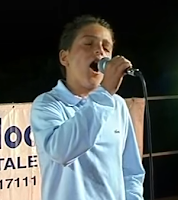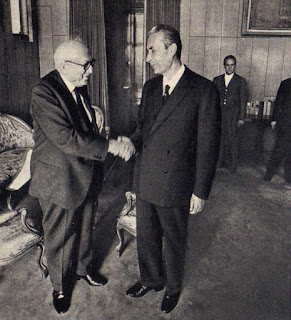NEW - Gianluca Ginoble – singer
Versatile baritone helps make Il Volo’s magical sound
Gianluca Ginoble, a member of the hugely successful and award winning Italian pop and opera trio Il Volo, was born on this day in 1995 in Roseto degli Abruzzi, in the Abruzzo region. He is the youngest of the trio and the only baritone. The other two singers, Piero Barone and Ignazio Boschetto, are both tenors. Gianluca’s family lives in Montepagano, a small hilltop town overlooking Roseto degli Abruzzi. He is the oldest son of Ercole Ginoble and Eleonora Di Vittorio and has a younger brother, Ernesto. Gianluca started to sing when he was just three years old with his grandfather, Ernesto, in the Bar Centrale, which Ernesto owns, in the main square of the town. While still young, Gianluca took part in music festivals and competitions in his area, winning some and being distinguished in them all because of his beautiful deep voice. In 2009, he won the talent show Ti Lascio Una Canzone on Rai Uno, singing Il mare calmo della sera, which had been Andrea Bocelli's winning song at the Sanremo Music Festival of 1994. He was then just 14 years old. Piero Barone and Ignazio Boschetto also took part in the show and in one episode the trio performed together for the first time, singing the Neapolitan classic, O sole mio. Read more…
__________________________________________________________________
Carlo Sartori – footballer
Italian was first foreigner to play for Manchester United
Carlo Domenico Sartori, the first footballer from outside Great Britain or Ireland to play for Manchester United, was born on this day in 1948 in the mountain village of Caderzone Terme in Trentino. The red-haired attacking midfielder made his United debut on October 9, 1968, appearing as substitute in a 2-2 draw against Tottenham Hotspur at the London club’s White Hart Lane ground. On the field were seven members of the United team that had won the European Cup for the first time the previous May, including George Best and Bobby Charlton, as well as his boyhood idol, Denis Law, who had missed the final against Benfica through injury. Sartori, who made his European Cup debut against the Belgian side Anderlecht the following month, went on to make 56 appearances in four seasons as a senior United player before returning to Italy to join Bologna. Although they dominate the Premier League today, players from abroad were a rarity in British football in Sartori’s era and United did not have another in their ranks until they signed the Yugoslav defender Nikola Jovanovic from Red Star Belgrade in 1980. Read more…
__________________________________________________________________
Louis Visconti - architect
Roman who made his mark on Paris
The architect Louis Visconti, who designed a number of public buildings and squares as well as numerous private residences in Paris, was born on this day in 1791 in Rome. Notably, Visconti was the architect chosen to design the tomb to house the remains of Napoleon Bonaparte after King Louis Philippe I obtained permission from Britain in 1840 to return them from Saint Helena, the remote island in the South Atlantic where the former emperor had died in exile in 1921. Born Louis Tullius Joachim Visconti, he came from a family of archaeologists. His grandfather, Giambattista Antonio Visconti was the founder of the Vatican Museums and his father, Ennio Quirino Visconti, was an archaeologist and art historian. Ennio had been a consul of the short-lived Roman Republic, proclaimed in February 1798 after Louis Alexandre Berthier, a general of Napoleon, had invaded Rome, but was forced to leave with the restoration of papal control. He and his family moved to Paris and were naturalised as French citizens, with Ennio becoming a curator of antiquities and paintings at the Musée du Louvre. In 1808, Louis enrolled at Paris's École des Beaux-Arts. Read more…
_________________________________________________________________
Carlo Carrà - Futurist artist
Painter hailed for capturing violence at anarchist's funeral
The painter Carlo Carrà, a leading figure in the Futurist movement that gained popularity in Italy in the early part of the 20th century, was born on this day in 1881 in Quargnento, a village about 11km (7 miles) from Alessandria in Piedmont. Futurism was an avant-garde artistic, social and political movement that was launched by the poet Filippo Tommaso Marinetti in 1909 and attracted many painters and sculptors, designers and architects, writers, film makers and composers who wished to embrace modernity and free Italy from what they perceived as a stifling obsession with the past. The Futurists admired the speed and technological advancement of cars and aeroplanes and the new industrial cities, all of which they saw as demonstrating the triumph of humanity over nature through invention. They were also fervent nationalists and encouraged the youth of Italy to rise up in violent revolution against the establishment. The movement was associated with anarchism. Indeed, Carrà counted himself as an anarchist in his youth and his best known work emerged from that period, when he attended the funeral of a fellow anarchist, Angelo Galli, who was killed by police during a general strike in Milan in 1906. Read more…
_________________________________________________________________
Lateran Treaty
How the Vatican became an independent state inside Italy
An agreement between the Kingdom of Italy and the Holy See, recognising the Vatican as an independent state within Italy, was signed on this day in 1929. The Lateran Treaty settled what had been known as ‘The Roman Question’, a dispute regarding the power of the Popes as rulers of civil territory within a united Italy. The treaty is named after the Lateran Palace where the agreement was signed by prime minister Benito Mussolini on behalf of King Victor Emmanuel III and Cardinal Pietro Gasparri on behalf of Pope Pius XI. The Italian parliament ratified the treaty on June 7, 1929. Although Italy was then under a Fascist government, the succeeding democratic governments have all upheld the treaty. The Vatican was officially recognised as an independent state, with the Pope as an independent sovereign ruling within Vatican City. The state covers approximately 40 hectares (100 acres) of land. The papacy recognised the state of Italy with Rome as its capital, giving it a special character as ‘the centre of the catholic world and a place of pilgrimage’. The Prime Minister at the time, Benito Mussolini, agreed to give the church financial support in return for public support from the Pope. Read more...
Home





























